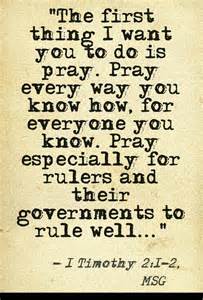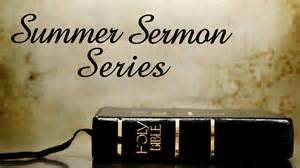“How to Worship?”

1 Timothy 2:1-4 – September 22, 2019
Have you ever been to a different kind of worship service? A service where people prayed differently, sang different kinds of songs, played different instruments, and even spoke in different languages? I have attended a number of different kinds. Worship of God can be diverse and different, depending on where we live, what each of us grows up with, and what kind of faith tradition we come from.
In today’s reading from the first letter to Timothy, we hear about instructions for prayer and worship. This letter to Timothy is one of the pastoral letters from the New Testament. In other words, this letter contains instructions for a church leader on how to be a better pastor and leader of a congregation. Including—recommendations for corporate worship and prayer.
This is not like the instructions from the Sermon on the Mount in Matthew or the Sermon on the Plain from Luke, where our Lord Jesus gives specific instructions for personal, private prayer. No, this letter is from several decades later, when there were established groups of believers, and they needed structure and direction on corporate worship and prayer.
From 1 Timothy 2: “I urge, then, first of all, that petitions, prayers, intercession and thanksgiving be made for all people—” This sounds wonderful! I have experienced this aspect of prayer in practically every worship service I have ever attended. I suspect you have, too.
Whether prayer happens from the pulpit or lectern, or from the floor of the church, whether the prayer is offered by members of the congregation from the pews or seated in a circle, extemporaneously or written out, Paul’s recommendation of unified prayer is definitely one that has gone on as long as believers in Christ have gathered together.
However, the prayers we offer are not just generic prayers. I want to remind everyone (and I am reminding myself, too!), that we are encouraged to “offer prayers for all members of the human family during church services; prayer in the terms of: petitions (general requests to God), Intercessions (requests for those in need), supplications (requests for ourselves), and thanksgivings.” [1] The apostle Paul is quite specific here! All of these different kinds of prayer!
I wonder: are your prayers—are my prayers—as far-ranging and thorough as these? Are these recommendations something we all can get on board with? Something we all follow?
Let’s continue with this reading from chapter 2. Who should we pray for? “for kings and all those in authority, that we may live peaceful and quiet lives in all godliness and holiness.”
We are not talking about good-tempered rulers. No, the kings, rulers and those in authority in the later half of the first century were not nice guys. What happens when we have mean rulers and cruel leaders, those in authority who do such wicked things as throw people out of their homes, put them in jail, even force them into exile, or even death?
Let’s take a look at the Roman emperors Tiberias, Caligula and Nero. None of them were particularly “good or nice,” several showed signs of mental instability, and these men were at the pinnacle of power in the Roman Empire for over 25 years. Yet, the apostle Paul recommended that his fellow believers pray for them, for other rulers, and “for those in authority, that we may live peaceful and quiet lives in all godliness and holiness.”
This was an instruction Timothy received for his regular worship services! What was the apostle thinking of? The Rev. Bryan Findlayson suggests “Such prayer seeks to restrain the powers of evil and so encourage peace and security. When society is in a state of peace, believers can freely serve both God and mankind.” [2]
Again, what about rulers and those in authority who persecute Christians? What about governments that destroy churches, jail church leaders and ministers, and make it impossible for Christians to live and raise families? What about those governments? Do we still need to pray for those wicked people? We are to pray for peace, but what kind of peace?
I would say, yes, especially for those wicked people in government who persecute Christians. “Most often our prayers for peace concern our own personal well-being. When society is at peace, life can go well for us and we can build that extra barn. Yet, the peace Paul has in mind is a positive environment for the proclamation and hearing of the gospel.” [3]
September 21st is the International Day of Peace. The website specifically for this day states: “Established in 1981 by unanimous United Nations resolution, Peace Day provides a globally shared date for all humanity to commit to Peace above all differences and to contribute to building a Culture of Peace.” [4] What a wonderful thing to contribute to building: peace.
Moreover, as the apostle Paul reminds us, peace in the world involves a positive environment for proclaiming and hearing the Good News of our Lord Jesus Christ. Is our government corrupt? We need to pray for the members of a wicked and corrupt administration, then. What matters even more is that we are safe to proclaim the Good News of the Lord, and to provide for a way to let everyone know the Good News of salvation through His name.
Division and divisiveness is not conducive to spreading the Good News. This current-day division and animosity between people who call themselves believers must make God very sad. Christians of all communities and all ethnicities ought to have their wonderful belief in Christ to unite them. But, no. Sadly, believers all over the world allow politics to divide them.
The Rev. J. Vernon McGee had this to say: “We need to pray for our country, and we need to pray for those who have authority over us. If you are a Republican and a Democrat is in office, pray for him. If you are a Democrat and a Republican is in office, pray for him.” [5]
We have been thinking about the unity of believers from all parts of the world for several weeks now. In our bible study, we are studying the book of Philippians, and talking about how the apostle Paul and his friends preached the Good News to a diverse and different population in the regional capital of Macedonia, Philippi. Diverse and different individuals came together to worship the Lord Jesus Christ, and God made it possible for them all to join in worship.
What a wonderful example to lift up! Can we do the same, here, now? We here at St. Luke’s Church can strive for the same unity and friendship, despite differences in our families, the languages we spoke as children, or the towns where we were born. We can also come together in worship, despite differences in worship styles, or singing, or prayer.
I pray at the beginning of most services here for God to bless our time in worship, and especially to aid us in lifting our vices in words, prayer and song. This is truly what God calls us all to do. Moreover, God looks upon every voice raised in prayer, praise, or song as legitimate worship, no matter what, no matter where, no matter how. We are all encouraged to do the same. We have God’s word on it!
Alleluia, amen!
(Suggestion: visit me at my regular blog for 2019: matterofprayer: A Year of Everyday Prayers. #PursuePEACE – and my other blog, A Year of Being Kind . Thanks!
[1] http://www.lectionarystudies.com/sunday25ce.html “Worship in the Church,” Rev. Bryan Findlayson, Lectionary Bible Studies and Sermons, Pumpkin Cottage Ministry Resources.
[2] Ibid.
[3] Ibid.
[4] https://internationaldayofpeace.org/
[5] McGee, J. Vernon, Thru the Bible: 1 Corinthians through Revelation, Vol 5, (Nashville TN: Thomas Nelson Publishing, 1983) 436.


